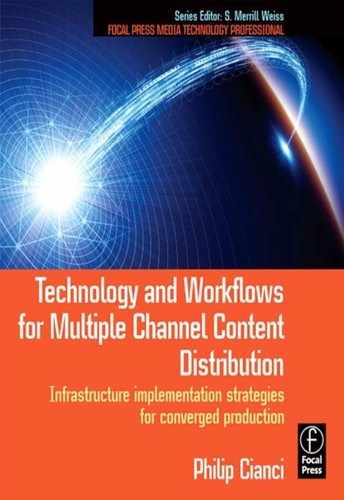CHAPTER
11
The interstitial
WHERE WE'VE BEEN
We began by discussing just how the media industry came to this new realm. All three of the delivery channels—television, Internet, and cellular networks—have been around for over a decade. But the combination of increased user uptake and technological innovation has led to this magic moment of alignment and facilitated this new media age. In a very short span of few years, it may be possible that any content at all can be consumed at any time, any place, on any device; however, we're still a long way from the day when ALL content can be consumed regardless of time, location, or device.
This led to a description of just what each of the three device types, the natural extension of the three-screen model, has to offer. What are the user expectations and experience in each domain?
WHERE WE ARE
At this point, a reader should have an improved understanding of how technology, creative and business factors, and goals impact the media industry.
Media systems are deceptively simple on the surface, but increasingly more complex as one gets deeper and deeper into infrastructure details.
The reader should have an appreciation of the need to do a meaningful workflow analysis and a technology process analysis, and then an analysis of how the two fit together. Yes, technologists are analytic when evaluated for communication and personality characteristics at Charm School. Six Sigma and other techniques can aid in developing methods that improve efficiency and increase ROI.
WHERE WE ARE GOING
Technology for technology's sake is fine, but it really serves no purpose or adds any real value to existence. With all the potential that comes with new media, is it fair to ask to what end will it be applied? Will the world be a better place, and will life become easier because of these technological advances? Or will the vast “TV waste-land, ” described by FCC Chairman Newton N. Minow at the 1961 NAB Conference, expand to all corners of the new media universe?
THE WHOLE SHEBANG
As we've discussed, moving from TV-centric production and distribution to repurposing TV content over new media channels is more than just an exercise in scaling up an infrastructure. There are fundamental differences in all aspects of production and content assembly, both technical and creative, that must be addressed. And of course technology and creativity cannot stand on their own; they must have a basis in a new media business model.
The lesson to be learned here is twofold. First, don't be fooled by simple work-flow and functional block diagrams; media technologies are sophisticated. Second, the fact that a media infrastructure is now a mixed bag—a system of systems— pushes complexity to nearly infinity.
This brings us to the second point: As complicated as the foundation technologies may be, as sophisticated as each system is, and as mind-boggling as the entire infra-structure is, they are within the reach of mastery by engineers and technologists. But professional egos must be put aside. It is a stark truth that no one person can under-stand all aspects of the infrastructure to the technical and practical depth necessary to design and commission a robust and resilient facility. It just cannot be done.
So as the lines of creative, technical, and business distinctions disappear while the industry moves farther into this new universe in the twenty-first century, it is important to remember that we are all in this together. And to liberally paraphrase ol’ Ben Franklin, we must all work together in a holistic approach, lest the opportunities before the television and media industry collapse, leaving nothing behind but the confusion and dust—unfulfilled promises of a more connected existence.
